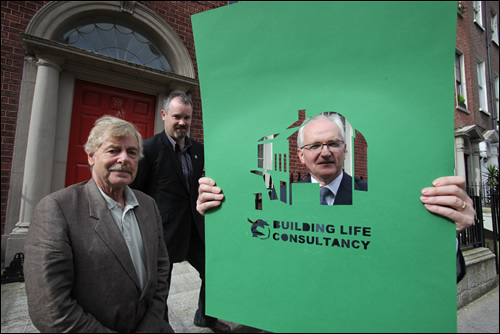- Events
- Posted
Building Life launches thermal bridging course

Building Life Consultancy is to hold two-day thermal bridge assessor workshops in Dublin on 16-17 February, 12-13 April, and 7- 8 June. The workshops are intended for architects, engineers, technologists, BER assessors, CEPH designers, insulation suppliers, and anyone with a focus on fabric performance and detailing.
"There has been increased demand for hands-on training in thermal bridge calculation and surface condensation risk assessment to meet the latest IS, BS, ISO Standards,” Building Life Consultancy’s Joseph Little told Construct Ireland.

Pictured at the launch of Building Life Consultancy in 2009 are (l-r) then Royal Institute of the Architects of Ireland
president Sean O’Laoire, architect Joseph Little, and then environment minister John
Gormley
Building Life Consultancy is to hold two-day thermal bridge assessor
workshops in Dublin on 16-17 February, 12-13 April, and 7- 8 June. The workshops are intended for architects, engineers, technologists, BER assessors, CEPH designers, insulation suppliers, and anyone with a focus on fabric performance and detailing.
"There has been increased demand for hands-on training in thermal bridge calculation and surface condensation risk assessment to meet the latest IS, BS, ISO Standards,” Building Life Consultancy’s Joseph Little told Construct Ireland.
“The new Part L for dwellings raises energy-efficiency standards significantly and places increased emphasis on calculating thermal bridges,” he said. “For instance many dwellings designed to have a Y-value of even 0.08 W/m2K will not comply.” Y-values are a measure of the total heat loss expected from all of the thermal bridge losses in all of the junctions in the house.
Little’s colleague Beñat Arregi warned that BER assessors are being audited for any high performing buildings submitted. “Assessors can only refer to the Department of the Environment’s Acceptable Construction Details where they are relevant, but otherwise need to provide thermal bridge calculations where the Y-values exceed 0.15 W/m2K,” he said.
Arregi said that insulation suppliers applying for NSAI Agrément certificates are now being asked to assess a larger number of thermal bridge junctions for their systems than before to aid the calculation of Y-values.
"The NSAI will announce its thermal bridge assessor scheme at the end of January 2012. Bear in mind they have currently set the bar for applicants at level 8 qualifications," Arregi said. The two day course costs €450, or €315 for anyone who joins CITA Skillnet.
"This course is practical, and it’s designed to meet the requirements of NSAI’s scheme,” said Little. “It will also help those designing passive house buildings. We deliberately focus on both Irish and UK regulations and international standards – for those who wish to sell their services abroad. The subject is not easy and the course will be intense. To aid this we’re providing good pre and post-learning. Familiarity with construction, CAD, Part L & U-value calculations will help participants greatly. A desire to learn is essential.”
The course also includes course notes, lunch and coffee breaks, one-on-one tuition several times through both days and homework for the first evening to reinforce learning in the day. Class sizes are being kept down to increase the participant-to-trainer ratio. “For those who don’t own a CAD package or haven’t drawn on computers before we will facilitate them with free software and a pre-learning pack,” said Little. The course is eligible for engineering and architecture CPD points.
For more information and to register your interest in the course, please see the Building Life Consultancy website.

